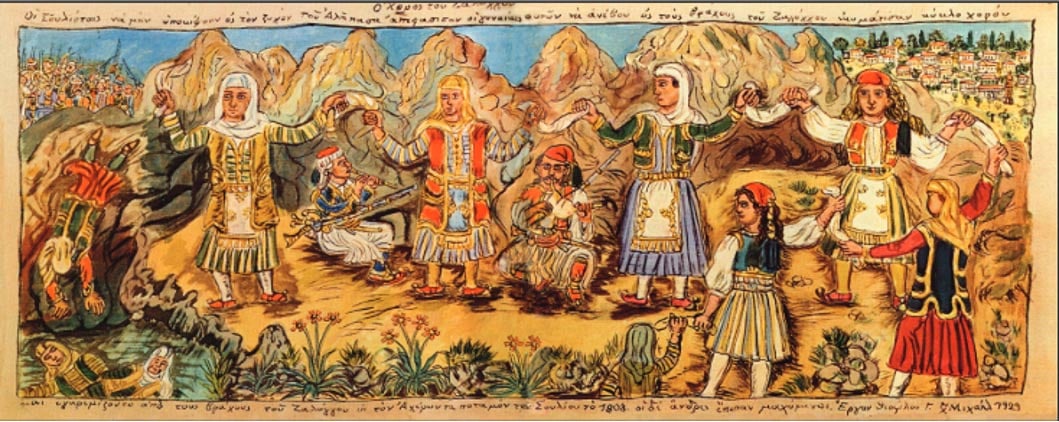From Here to Eternity: the Tragic Tale of the Dance of Zalongo
Once known as the birthplace of Alexander the Great's mother Olympia, the former Ottoman Empire region of Epirus has a much more recent historical significance. Under the reign of Ali Pasha, a Muslim governor in the eighteenth and nineteenth centuries, Epirus was home to the great mountain of Zalongo, settled by the people called Souli. In 1803, Ali Pasha's determination to gain more territory and subdue the strong Souliot Confederacy became so fierce that he was driven toward ideas of genocide to defeat them. While he was not successful in that avenue, the Zalongo mountain of Epirus is stained with the blood of dozens of women and children whose rebellion took the form of a mass suicide, otherwise known as their Dance of Zalongo.
The Repression of the Souliot
For many years, the Souliot people had lived in a confederacy within the Ottoman Empire's Epirus region, contentedly left to their own devices. Yet in the early eighteen hundreds, the Sultan chose to lay siege to the confederacy, forcing the Souliot clans into disarray until their unity was broken. Some families left their Souli community but, unable to escape Ali Pasha, were forced to endure a months-long siege meant to overtake them. Yet, it was those who chose to remain behind who suffered most at the hands of Ali Pasha.
With the permission of the Ottoman Sultan on his side, Ali Pasha signed a peace treaty with the Souliot people who remained in Epirus, allowing them to stay and continue their life there without further threat or interference from the Ottomans. Thus to the mountain of Zalongo hundreds moved with the certainty that their lives and land were safe from the advances of Ali Pasha and his brutal followers.

Ali Pasha of Janina Hunting on Lake Butrinto (1825), Louis Dupré (Wikimedia Commons)
Yet this vow of protection was in the end a terrible ruse. As soon as he was able, Ali Pasha issued orders to seize the remaining Souliots and kill the men while forcing the women and children into slavery. With an audience of over a hundred friends, neighbors, and family members, all slaughtered or shackled before them, fifty plus women began to dance on the edge of the cliffs of Zalongo.
- Mass suicide at Pilenai: Lithuanian Defenders Choose Death over Enslavement
- Hell hath no fury like the Trung Sister freedom fighters
- Jauhar - The History of Collective Self Immolation during War in India
- Ancient tablets reveal whole family underwent Sallekhana, ritual fasting unto death
The Dance of Zalongo: to Eternity Over Enslavement
As each woman gained the edge of the cliff, she gallantly threw the child in her arms careening to his or her death, ending the child's short life at the base of the mountain—not necessarily with the child's foreknowledge. Then each mother followed her child to her own end, purportedly bravely facing death with open arms. In the great choice between enslavement and eternity, these women chose for themselves and their children eternity.

Zalongos Dance, Claude Pinet (Helleniccomserve)
Memories of the Fearless Dancers
This event soon became known throughout the east and even into Continental Europe, a tale of the fearless dancing troupe of women who gave their lives to maintain their dignity. Though it is unknown for certain, the newfound myth claimed that the women sang and danced to folk music as they plunged to their deaths, transforming the act of rebellion into a romanticized, ritualistic ceremony.

The Souliot Women (1827), Ary Scheffer (Wikimedia Commons)
The women's tale was immortalized when it reached Europe, both in the Greek song entitled "The Dance of Zalongo", as well as in various Romantic paintings of the time. In the late twentieth century, the sacrifice of the Souliot women was once again honored in the form of the Monument of Zalongo made by George Zongolopoulos, and visible several hundred meters high upon the edge of Mount Zalongo's cliff. The monument depicts six abstract women of descending height, in what appears to be a profile view of their supposed dance, the valiant moment in time perpetually frozen in time for all to see.

The Monument of Zalongo, Mount Zalongo, Greece (The Vale of Soul-Making)
Featured Image: The Dance of Zalongo, Theophilos Hatzimichail (Helleniccomserve)
By Riley Winters
References
Battle, William James. "Greece at the Peace Table." The Classical Journal. 16.1. October 1920, p. 2-14. http://www.jstor.org.proxy.its.virginia.edu/stable/3287885
Franklin, Michael J. "Jousting for the Honour of Greece and 'a certain miss phrosyne': Baron Byron and Gally Knight Clash over Costume, Correctness, and a Princess." The Modern Language Review. 103.2. April 2008, p. 330-349. http://www.jstor.org.proxy.its.virginia.edu/stable/20467776
Freeman, Edward. Ottoman Power in Europe, Its Nature, Its Growth, and Its Decline (Adamant Media Corporation: Boston, 2004.)
Michaelides, Solon. "Greek Song-Dance." Journal of the International Folk Music. 8.1. 1956, p. 37-39. http://www.jstor.org.proxy.its.virginia.edu/stable/834745
Papoutsy, Christos. The Dance of Zalongo (CreateSpace Independent Publishing: Seattle, 2012.)

















